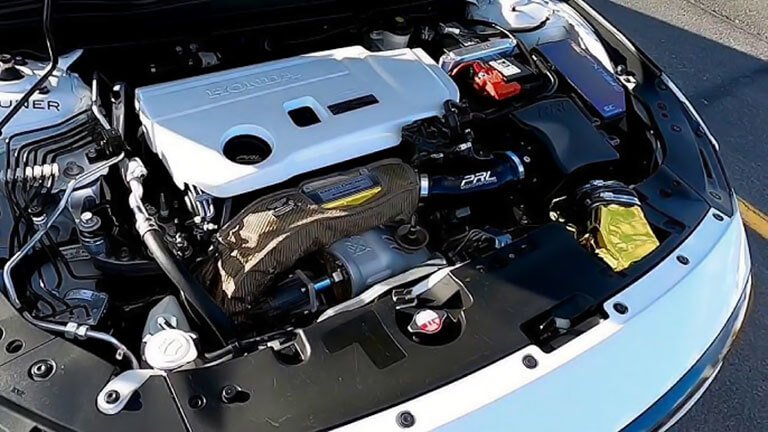Honda 2.0 Turbo Engine Problems: Quick Fixes & Tips
Honda’s 2.0 Turbo engine may face issues like excessive oil consumption and turbocharger failure. Drivers have reported problems with engine performance and reliability.
The Honda 2. 0 Turbo engine has garnered attention for its impressive performance and efficiency. However, some owners have encountered notable problems that raise concerns. Issues such as excessive oil consumption and premature turbocharger failure can impact driving experience and vehicle longevity.
These challenges often lead to costly repairs and may diminish the engine’s reputation for reliability. Understanding the root causes of these problems is crucial for Honda enthusiasts and potential buyers. Awareness can help in making informed decisions about maintenance and care, ultimately ensuring the engine performs as intended. Addressing these concerns promptly can enhance overall satisfaction with this powerful engine option.
Introduction To Honda’s 2.0 Turbo Engine

The Honda 2.0 Turbo engine has gained popularity for its impressive performance. This engine offers a blend of power and efficiency, appealing to many drivers. It powers models like the Honda Accord and Civic. While it has many strengths, some owners report issues that need attention.
Popularity And Performance
The Honda 2.0 Turbo engine stands out in the market. Here are some key points about its popularity:
- Efficiency: It delivers great fuel economy.
- Power: Produces high horsepower and torque.
- Technology: Features advanced engineering for smooth rides.
- Versatility: Used in various Honda models.
Many drivers love the performance of this engine. It accelerates quickly and handles well. Drivers often mention the joy of driving with this engine.
Common Issues Faced By Owners
Despite its popularity, some owners face problems. Here are common issues reported:
| Issue | Description |
|---|---|
| Turbo Lag | Delay in power delivery during acceleration. |
| Oil Consumption | Excessive oil usage over time. |
| Overheating | Engine temperature rises beyond normal limits. |
| Check Engine Light | Warning light indicating engine problems. |
Owners should monitor their vehicles closely. Regular maintenance helps prevent many issues. Addressing problems early can save money and enhance performance.
Oil Dilution In Turbo Engines
Oil dilution is a common issue in turbo engines, especially in Honda vehicles. This problem occurs when fuel mixes with engine oil. It can lead to serious engine damage if not addressed. Understanding the causes and symptoms is crucial for every Honda owner.
Symptoms Of Oil Dilution
Recognizing the symptoms of oil dilution can save your engine. Here are the main signs:
- Frequent Oil Changes: You notice the need for oil changes more often.
- Lower Oil Level: The oil level drops quickly.
- Fuel Smell in Oil: A strong fuel odor is present in the oil.
- Engine Noise: You hear unusual noises from the engine.
- Check Engine Light: The warning light appears on your dashboard.
Steps To Address Oil Dilution
Taking action against oil dilution is essential. Follow these steps:
- Check Oil Level: Use the dipstick to check the oil level.
- Change Oil: Replace the oil with high-quality synthetic oil.
- Inspect Fuel System: Look for leaks in the fuel system.
- Monitor Driving Habits: Avoid short trips that do not reach optimal temperature.
- Regular Maintenance: Follow the maintenance schedule for your Honda.
Ignoring oil dilution can lead to costly repairs. Stay proactive with your vehicle’s health.
Turbocharger Failure Symptoms
Turbocharger failure can cause serious engine issues. Recognizing the symptoms early can save time and money. Understanding these signs helps maintain your Honda’s performance.
Recognizing Turbocharger Issues
Several symptoms indicate turbocharger problems. Keep an eye on these signs:
- Loss of Power: Noticeable drop in acceleration.
- Whining Noise: Unusual sounds from the engine.
- Excessive Exhaust Smoke: Blue or black smoke from the exhaust.
- Check Engine Light: Warning light illuminates on the dashboard.
- Increased Fuel Consumption: More fuel used than usual.
Diagnosing Turbocharger Problems
Diagnosing turbocharger issues requires some steps. Follow this ordered list:
- Check for warning lights on the dashboard.
- Inspect for unusual noises during acceleration.
- Monitor exhaust smoke color and amount.
- Evaluate engine performance and responsiveness.
- Review fuel consumption records for any spikes.
Use the following table for a quick symptom overview:
| Symptom | Possible Cause |
|---|---|
| Loss of Power | Turbocharger failure |
| Whining Noise | Worn bearings or damaged turbine |
| Excessive Exhaust Smoke | Oil leaks or fuel issues |
| Check Engine Light | Sensor malfunction |
| Increased Fuel Consumption | Boost leaks or turbo damage |
Acting quickly can prevent further damage. Regular maintenance helps avoid turbocharger issues.
Fuel System Malfunctions
The Honda 2.0 Turbo engine faces various fuel system malfunctions. These issues can lead to poor performance and engine damage. Understanding these problems helps owners take action early. Two common malfunctions are high-pressure fuel pump failures and fuel injector defects.
High-pressure Fuel Pump Failures
High-pressure fuel pumps are crucial for engine performance. They maintain the correct fuel pressure for optimal combustion. Failures in these pumps can cause various symptoms:
- Engine misfires
- Poor acceleration
- Unusual noises from the fuel tank
- Check engine light activation
Common causes of high-pressure fuel pump failures include:
- Contaminated fuel
- Overheating
- Electrical issues
Replacing the high-pressure fuel pump often resolves these issues. Regular maintenance can help prevent failures.
Fuel Injector Defects And Solutions
Fuel injectors deliver fuel to the engine. Defects in these components can lead to serious problems. Symptoms of faulty fuel injectors include:
- Rough idling
- Increased fuel consumption
- Unburned fuel in the exhaust
Common fuel injector defects include:
| Defect Type | Description |
|---|---|
| Clogged Injector | Debris prevents fuel flow. |
| Leaking Injector | Fuel leaks into the engine. |
| Electrical Failure | Loss of signal disrupts fuel delivery. |
Cleaning or replacing the injectors can restore function. Regular fuel system inspections help catch these defects early.
Cooling System Complications
The Honda 2.0 Turbo engine faces several cooling system complications. These issues can lead to serious engine damage. Understanding these problems helps in maintaining your vehicle.
Overheating And Its Prevention
Overheating is a common problem in the Honda 2.0 Turbo engine. It can cause severe engine damage. Here are some causes of overheating:
- Low coolant levels
- Faulty thermostat
- Clogged radiator
- Damaged water pump
Prevent overheating by following these tips:
- Check coolant levels regularly.
- Inspect the thermostat for proper function.
- Flush the radiator every two years.
- Replace damaged water pumps immediately.
Radiator And Coolant Troubleshooting
The radiator plays a vital role in the cooling system. Issues can arise, leading to poor engine performance. Here are common radiator problems:
| Problem | Symptoms | Solutions |
|---|---|---|
| Leaks | Coolant puddles under the car | Repair or replace the radiator |
| Clogs | Overheating engine | Flush the radiator |
| Corrosion | Discolored coolant | Replace the radiator |
Regularly inspect the coolant for signs of contamination. Clean the radiator to prevent clogs. Ensure all hoses are secure and free from leaks.
Exhaust Smoke And Emission Problems
The Honda 2.0 Turbo engine can face serious issues with exhaust smoke and emissions. These problems can affect performance and increase environmental impact. Understanding the types of exhaust smoke helps diagnose the issue quickly.
Types Of Exhaust Smoke
Exhaust smoke can vary in color, each indicating different problems. Here are the main types:
| Color of Smoke | Possible Cause |
|---|---|
| Blue Smoke | Oil burning in the combustion chamber. |
| White Smoke | Coolant entering the engine, often due to a blown head gasket. |
| Black Smoke | Excess fuel burning, possibly from a faulty sensor. |
Recognizing these colors helps identify the root cause quickly. This can save time and money on repairs.
Emission Control Techniques
Honda uses various techniques to control emissions effectively. These methods help reduce harmful pollutants.
- Catalytic Converter: Converts harmful gases into less harmful emissions.
- Oxygen Sensors: Monitor air-fuel mixture for optimal combustion.
- Evaporative Emission Control System (EVAP): Prevents fuel vapors from escaping into the atmosphere.
Maintaining these components is crucial for lowering emissions. Regular checks can prevent serious problems down the line.
Electronic Control Unit (ecu) Errors
The Electronic Control Unit (ECU) plays a crucial role in the Honda 2.0 Turbo engine. It manages engine functions and optimizes performance. Errors in the ECU can lead to various issues. Understanding these problems helps in effective troubleshooting.
Ecu Fault Symptoms
Identifying ECU faults is essential for maintaining engine health. Here are common symptoms:
- Check Engine Light: Illuminates on the dashboard.
- Poor Fuel Economy: Noticeably increased fuel consumption.
- Engine Stalling: Engine unexpectedly shuts off.
- Difficulty Starting: Engine struggles to start or doesn’t start.
- Unusual Engine Behavior: Erratic performance or misfiring.
Resetting And Reprogramming The Ecu
Resetting the ECU can solve minor issues. Follow these steps to reset it:
- Disconnect the negative battery terminal.
- Wait for about 15 minutes.
- Reconnect the battery terminal.
- Start the engine and let it idle for 10 minutes.
- Drive the vehicle to allow the ECU to reprogram.
Reprogramming may require specialized tools. It is best performed by a professional mechanic.
Maintenance Tips For Longevity
Keeping your Honda 2.0 Turbo engine in great shape requires regular care. Simple maintenance can extend engine life and improve performance. Below are essential tips for ensuring longevity.
Regular Check-ups And Service Intervals
Sticking to a service schedule is crucial. Follow these check-up tips:
- Check oil levels every month.
- Change oil every 5,000 to 7,500 miles.
- Inspect air filters every 15,000 miles.
- Replace spark plugs every 30,000 miles.
Regular inspections help catch problems early. Look for:
- Leaks in the engine.
- Unusual noises during operation.
- Warning lights on the dashboard.
Set reminders for service appointments. A well-maintained engine runs smoother and lasts longer.
Performance Upgrades And Their Impact
Upgrades can improve performance but may affect engine health. Consider these points:
| Upgrade | Potential Benefits | Possible Risks |
|---|---|---|
| Cold Air Intake | Increased airflow, better throttle response | May require more frequent cleaning |
| High-Performance Exhaust | Improved horsepower, better sound | Can affect emissions |
| ECU Tuning | Enhanced performance, better fuel efficiency | Potential for engine strain |
Before upgrading, research compatibility. Consult a professional mechanic for advice. Balance performance with engine longevity for the best results.
Quick Fixes For Common Concerns
The Honda 2.0 Turbo engine is known for its performance. However, it can face some issues. Quick fixes can help address these problems effectively. Below are solutions for common concerns.
Temporary Solutions For Immediate Problems
Sometimes, quick fixes can solve immediate issues. Here are some easy solutions:
- Check the Oil Level: Low oil can cause engine problems. Ensure it’s at the right level.
- Inspect the Cooling System: Overheating can damage the engine. Look for leaks or low coolant levels.
- Reset the ECU: A simple reset can resolve minor electronic glitches. Disconnect the battery for a few minutes.
- Replace the Air Filter: A dirty air filter can reduce performance. Change it regularly.
| Problem | Quick Fix |
|---|---|
| Oil Leak | Check oil levels and tighten loose bolts. |
| Overheating | Inspect coolant levels and hoses. |
| Rough Idling | Clean the throttle body. |
| Check Engine Light | Use an OBD-II scanner to identify the issue. |
When To Seek Professional Help
Some issues require expert attention. Know when to seek help:
- Persistent Warning Lights: If warning lights stay on, consult a mechanic.
- Unusual Noises: Grinding or knocking sounds can indicate serious problems.
- Loss of Power: A sudden drop in performance needs immediate inspection.
- Frequent Overheating: This can lead to severe engine damage.
Stay proactive. Regular maintenance prevents many problems. Address concerns quickly to keep your Honda running smoothly.
Frequently Asked Questions
What Are Common Honda 2.0 Turbo Issues?
Common issues include oil leaks, turbocharger failures, and excessive engine noise.
How Reliable Is The Honda 2.0 Turbo Engine?
The Honda 2. 0 Turbo engine is generally reliable but may have specific problems reported by some users.
What Symptoms Indicate Turbo Problems?
Symptoms include reduced power, unusual sounds, and warning lights on the dashboard.
Can I Fix Honda 2.0 Turbo Problems Myself?
Some minor issues can be fixed at home, but complex repairs are best handled by professionals.
How To Prevent Honda 2.0 Turbo Engine Problems?
Regular maintenance, timely oil changes, and using quality fuel can help prevent issues. “`
Conclusion
Understanding the common issues associated with the Honda 2. 0 Turbo engine is crucial for potential buyers and current owners. Regular maintenance and timely repairs can significantly enhance performance and longevity. Stay informed about these problems to make better decisions for your vehicle.
Prioritize care to ensure a reliable driving experience.






